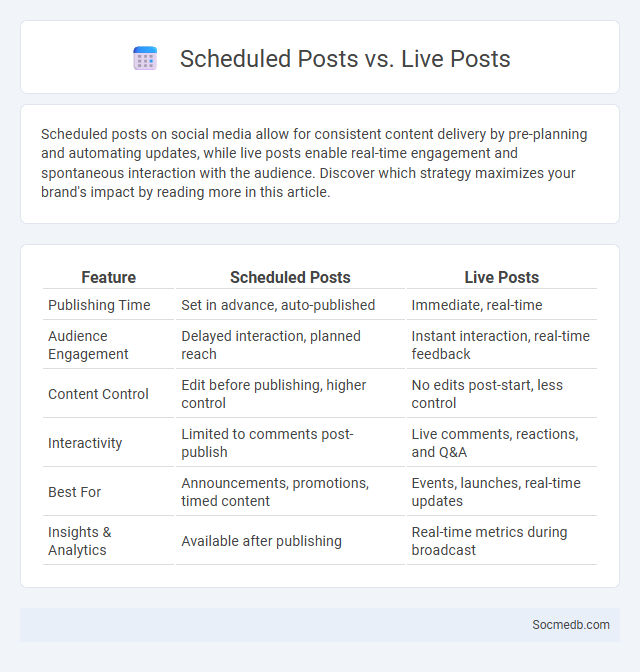
Photo illustration: Scheduled Posts vs Live Posts
Scheduled posts on social media allow for consistent content delivery by pre-planning and automating updates, while live posts enable real-time engagement and spontaneous interaction with the audience. Discover which strategy maximizes your brand's impact by reading more in this article.
Table of Comparison
| Feature | Scheduled Posts | Live Posts |
|---|---|---|
| Publishing Time | Set in advance, auto-published | Immediate, real-time |
| Audience Engagement | Delayed interaction, planned reach | Instant interaction, real-time feedback |
| Content Control | Edit before publishing, higher control | No edits post-start, less control |
| Interactivity | Limited to comments post-publish | Live comments, reactions, and Q&A |
| Best For | Announcements, promotions, timed content | Events, launches, real-time updates |
| Insights & Analytics | Available after publishing | Real-time metrics during broadcast |
Introduction to Social Media Content Strategies
Effective social media content strategies focus on understanding your target audience, selecting appropriate platforms, and creating engaging, relevant posts that drive interaction. Leveraging data analytics helps optimize content timing and formats to maximize reach and engagement. You can enhance brand visibility and foster loyal communities by consistently delivering personalized, value-driven content across multiple channels.
Defining Scheduled Posts: Structure and Purpose
Scheduled posts on social media are pre-planned content created and uploaded in advance to be published at specific dates and times. This structure allows businesses and influencers to maintain consistent engagement, optimize timing for target audience activity, and streamline content management. The main purpose of scheduled posts is to enhance efficiency, boost reach, and ensure a steady flow of communication without the need for real-time intervention.
What Are Live Posts? Key Features and Benefits
Live posts are real-time updates shared on social media platforms that enable immediate interaction with audiences through comments, reactions, and shares. Key features include instant broadcasting, live video streaming, and viewer engagement analytics, which help brands and influencers foster authentic connections. The benefits encompass enhanced audience trust, increased reach through algorithmic prioritization of live content, and immediate feedback to tailor content strategies effectively.
Understanding Viral Content: Characteristics and Impact
Viral content on social media typically features highly engaging visuals, relatable storytelling, and timely relevance, which drive rapid sharing and widespread visibility. Understanding these characteristics helps you create content that resonates deeply with your target audience, increasing your chances of achieving viral reach. The impact of viral content extends beyond mere popularity, often influencing trends, shaping public opinion, and enhancing brand credibility in competitive digital landscapes.
Audience Engagement: Scheduled vs Live vs Viral
Maximizing audience engagement on social media requires understanding the distinct impacts of scheduled, live, and viral content. Scheduled posts ensure consistent interaction by reaching your audience at peak times, while live content fosters real-time connection and authentic engagement through instant feedback. Viral content drives exponential reach and shares, rapidly amplifying your message beyond your usual followers.
Timing and Reach: Comparing Post Strategies
Optimizing social media post timing enhances reach by aligning content publication with peak user activity, maximizing engagement opportunities across platforms like Instagram, Facebook, and Twitter. Studies reveal that posting during early mornings, lunchtime, and evenings taps into diverse audience segments, improving visibility and interaction rates. Strategic timing combined with targeted audience analysis significantly amplifies the organic reach and effectiveness of social media campaigns.
Content Planning: When to Schedule, Go Live, or Target Virality
Effective content planning on social media involves scheduling posts during peak engagement hours specific to your audience demographics, typically early mornings, lunchtime, or evenings. You should go live when your followers are most active, often during weekdays and weekends around 7-9 PM, to maximize real-time interaction and visibility. Target virality by creating timely, relatable, and shareable content that aligns with trending topics and emotional triggers to encourage organic spread.
Analytics and Performance Metrics: Measuring Success
Social media analytics utilize key performance metrics such as engagement rate, reach, impressions, click-through rate, and conversion rate to measure campaign success and audience response. Tools like Google Analytics, Facebook Insights, and Hootsuite Analytics enable marketers to track real-time data, optimize content strategy, and improve ROI. By analyzing customer demographics, sentiment analysis, and traffic sources, brands can make data-driven decisions for targeted marketing and enhanced brand awareness.
Pros and Cons of Each Content Type
Video content on social media captures attention quickly and boosts engagement through dynamic storytelling, but it requires higher production effort and bandwidth. Image posts are visually appealing and easy to consume, enhancing brand recognition, yet they may lack depth and fail to convey complex messages effectively. Text-based content offers detailed information and supports SEO strategies, but it often struggles to stand out in fast-paced feeds, requiring You to craft compelling hooks to maintain audience interest.
Choosing the Right Approach for Your Brand
Selecting the appropriate social media strategy for your brand requires analyzing target audience behavior, platform demographics, and content preferences. Leveraging data from tools like Instagram Insights, Facebook Analytics, or LinkedIn Audience Insights helps tailor messages that resonate with potential customers. Consistently aligning your brand voice and visual identity across chosen platforms maximizes engagement and drives long-term growth.
 socmedb.com
socmedb.com